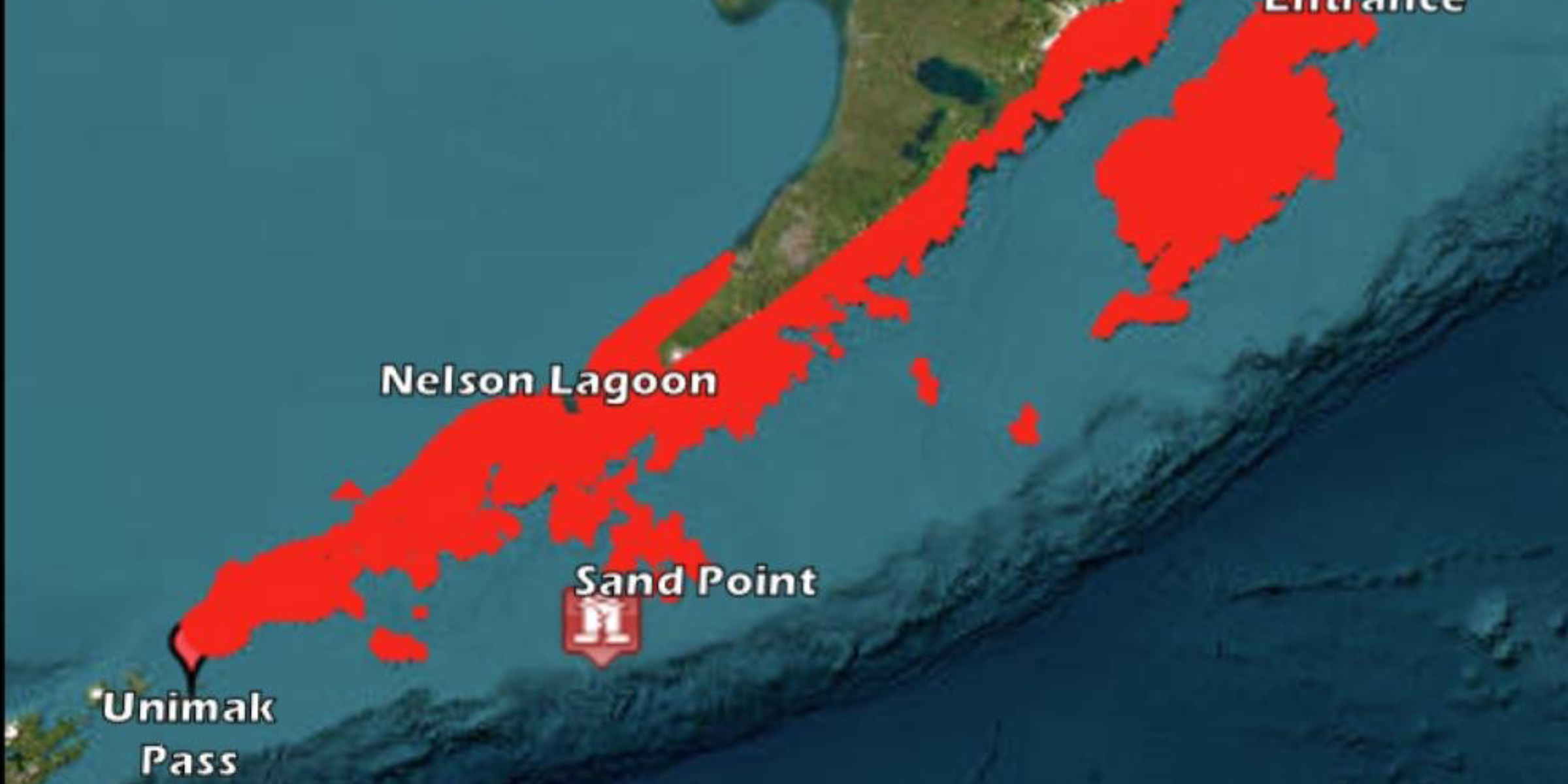
Magnitude 7.3 Earthquake Hits Alaska – Details & Videos
A powerful magnitude 7.3 earthquake struck off Alaska's southern coast on July 16, 2025, triggering a tsunami warning across the Alaska Peninsula and prompting evacuations before the threat was safely lifted.
At 12:37 p.m. AKDT on Wednesday, a magnitude 7.3 earthquake struck approximately 55 miles south of Sand Point, Alaska, at a depth of about 20 kilometers.
The tremor was felt widely across the Alaska Peninsula and southern Alaska. The National Tsunami Warning Center initially issued a tsunami warning for areas from Unimak Pass to Kennedy Entrance, covering roughly 700 miles of Alaska's southern coastline.
Evacuation alerts were given to places like King Cove, Kodiak, Unalaska, and Homer, where both the Coast Guard and state emergency services advised residents to seek higher ground. The warning was soon downgraded to an advisory and later fully canceled, after no significant sea-level changes were detected.
The National Tsunami Warning Center announced, "Tsunami cancellations indicate the end of the damaging tsunami threat. A cancellation is issued after an evaluation of sea level data confirms that a destructive tsunami will not impact the alerted region, or after tsunami levels have subsided to non-damaging levels."
An alert from the Anchorage Office of Emergency Management confirmed that there was no immediate danger to Anchorage residents.
While no immediate structural damage was reported, several videos posted on social media captured the earthquake's force. At Anchorage's Lake Hood Seaplane Base, pavement and aircraft shook violently as the tremors hit.
Another video recorded inside an Alaskan home showed ceiling fixtures and furniture swaying dramatically. A man could be seen rushing to rescue a child strapped into a high chair as falling wall fixtures nearly struck them. He, the baby, and a young girl scrambled to get to safety.
In Sand Point, city administrator Debi Schmidt called it the most powerful earthquake she had personally experienced, saying it was the "biggest one" she's ever felt.
The Alaska Earthquake Center (AEC) has reported at least 18 aftershocks, most registering between magnitudes 3 and 4, with more expected in the coming days. Though these are not considered of societal significance, experts are monitoring the possibility of further seismic activity.
Michael West, AEC Director and State Seismologist, noted that the 7.3 quake appears to be part of a long-running seismic sequence in the region. He said:
"There's a small percentage possibility that there will be a follow-on earthquake that is similar in size or larger, but there's no reason to anticipate that."
The AEC has been fielding a flood of public inquiries since the quake, offering updates to concerned residents across the state. The major quake followed an active week for seismic activity in the region: over 400 earthquakes had been recorded across the state.
Prior to this large event, the most significant quake had been a magnitude 5.1 near Atka. Among the week's events were three felt earthquakes near Anchorage, the Mat-Su Valley, and the Kenai Peninsula.
Coincidentally, the earthquake struck just one week after the anniversary of the 1958 Lituya Bay megatsunami — the tallest tsunami wave ever recorded worldwide. On July 9, 1958, a magnitude 7.8 earthquake ruptured 125 miles of the Fairweather Fault, triggering a massive landslide in Southeast Alaska's Lituya Bay.
That landslide crashed into the narrow fjord, displacing water with such force that it scoured the surrounding cliffs to bedrock, reaching a staggering elevation of 1,700 feet.
Initially believed to be caused by the quake itself, decades of scientific research have since determined that the landslide, along with contributing factors like glacier calving and underwater slumping, were the true cause.
While Alaska grappled with its own seismic unrest, residents in Southern California were also shaken by a series of earthquakes that struck the region in quick succession.
A cluster of earthquakes struck near Julian, California, on Monday, April 14, 2025. According to the United States Geological Survey (USGS), the first and strongest quake, a magnitude 5.2 event, occurred at 10:08 a.m. local time (17:08 UTC), centered 5 kilometers south of Julian at a depth of 14.3 kilometers.
Roughly an hour later, at 11:23 a.m. (18:23 UTC), a second quake measuring magnitude 4.0 struck 4 kilometers south-southeast of Julian, with a depth of 12.6 kilometers.
The third quake, measuring magnitude 2.9, followed at 1:23 p.m. (20:23 UTC). It was located 4 kilometers south of Julian at a depth of 12.7 kilometers.
According to CBS 8 San Diego, these events occurred less than 24 hours after a magnitude 3.5 earthquake hit the same area. Residents described how the quakes affected their surroundings and how they responded.
One unnamed resident recalled the experience, "The whole building started shaking. The parking lot literally felt like a wave under my feet. It was crazy."

A Julian resident shares his reaction to the series of earthquakes | Source: YouTube/cbs8sandiego
Another resident, Ashley Carter, was working from home when the tremor hit. "It just started going and it was getting worse, and then I got up and ran after the dog and we headed outside," she shared.

Ashley Carter recalls rushing outside with her dog as the shaking grew stronger | Source: YouTube/cbs8sandiego
At a local liquor store, manager Dylan Carnero recalled his first instinct once the shaking began. "Once I stopped hearing the bottles popping and everything. My first thought was just to get outside and onto the street and away from the buildings," he said.

Dylan Carnero stands inside his workplace after bottles fell during the quake | Source: YouTube/cbs8sandiego
In response to the earthquakes, Governor Gavin Newsom's office shared on X that he had been informed about the situation in San Diego County.
San Diego Gas & Electric (SDG&E) responded quickly by activating its Emergency Operations Center to check for damage. In a post on X, the company said crews began inspecting equipment near the epicenter and worked outward, moving as quickly as safety allowed.
The utility company also reminded residents to report gas leaks or downed power lines by calling 1-800-411-SDGE (7343) or 911 and warned the public to stay away from damaged electrical equipment.
According to a spokesperson for the San Diego Fire-Rescue Department, there was no damage or injuries despite the strength of the initial quake.
While San Diego avoided serious damage, other parts of the country have not been as fortunate, as extreme weather events continue to strike multiple regions.
A deadly tornado outbreak that began on the evening of March 14, 2025 devastated parts of the South and Midwest, leaving at least 18 people dead. The storms intensified the following day, causing widespread destruction in Mississippi and Louisiana and triggering a rare Tornado Emergency in Taylorsville, Mississippi.
Days before the event, the Storm Prediction Center (SPC) issued its highest threat level, warning of possible EF4 or stronger tornadoes. The first twisters touched down in Arkansas and Missouri before the severe weather moved southward.
On Saturday alone, the SPC recorded over a dozen tornado reports, with Mississippi and Alabama bearing the brunt. Mississippi's Walthall County saw at least two powerful tornadoes within 45 minutes.
In Tylertown, three deaths have been confirmed, though officials caution that the toll may rise as rescue teams continue searching through the debris. Initial surveys by the National Weather Service indicate some of the strongest tornadoes reached EF3 strength, with winds up to 165 mph.
Ongoing damage assessments could reveal even stronger tornadoes. As of Saturday afternoon, more than 50,000 customers across Louisiana, Mississippi, and Alabama were without power. The severe weather threat is expected to continue into Sunday, affecting nearly 70 million people from the Northeast to Florida.
An earthquake struck Mississippi, which added to the devastation as the state was still reeling from the powerful tornado outbreak. The seismic event further complicated rescue and recovery efforts, with officials working to assess the full extent of the damage caused by both natural disasters.
However, the severity of destruction depends on multiple factors beyond just the earthquake's magnitude. Variables such as proximity to the epicenter, soil composition, and structural integrity of buildings all play crucial roles.
Generally, significant damage is not expected unless an earthquake registers above a magnitude of 4 or 5, but local conditions can amplify its impact. Authorities are continuing assessments to determine the full extent of the situation.